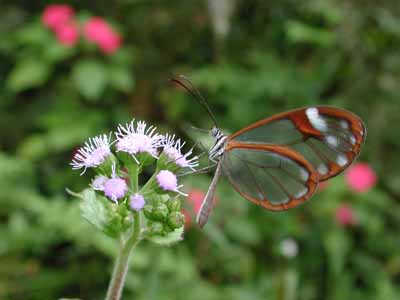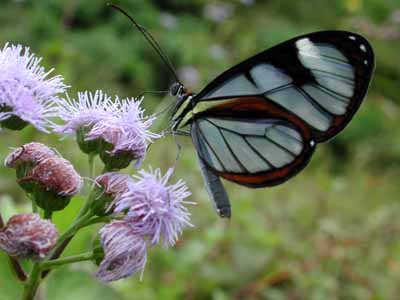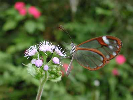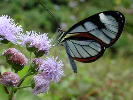Ithomiini
Chris Jiggins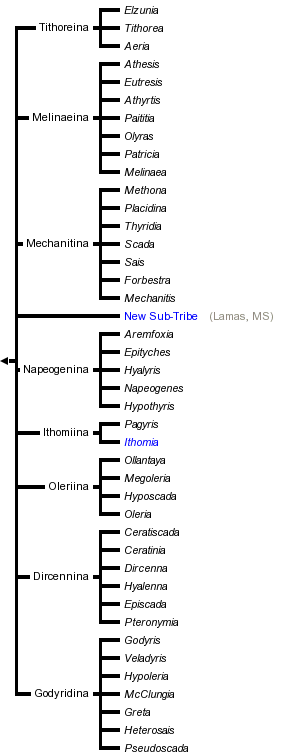


This tree diagram shows the relationships between several groups of organisms.
The root of the current tree connects the organisms featured in this tree to their containing group and the rest of the Tree of Life. The basal branching point in the tree represents the ancestor of the other groups in the tree. This ancestor diversified over time into several descendent subgroups, which are represented as internal nodes and terminal taxa to the right.

You can click on the root to travel down the Tree of Life all the way to the root of all Life, and you can click on the names of descendent subgroups to travel up the Tree of Life all the way to individual species.
For more information on ToL tree formatting, please see Interpreting the Tree or Classification. To learn more about phylogenetic trees, please visit our Phylogenetic Biology pages.
close boxIntroduction
The ithomiine butterflies are a diverse group of approximately 360 species that show huge diversity of colour pattern and form (Lamas 2004). Most species are involved in mimicry with one another and with other Lepidoptera, including the heliconiines.
Characteristics
The chemical ecology of these butterflies is fairly well known. Larvae of basal species feed on host plants in the family Apocynaceae, a host plant group shared with the related danaine butterflies. Most species, however feed on the Solanaceae, which is a very speciose and chemically diverse plant family. Most ithomiines are thought to be distasteful to predators, but interestingly some species do not sequester chemicals from their host plants (Brown 1984a & b). Instead the males collect pyrrolizidine alkaloids from flowers (especially Asteraceae) and rotting leaves (mainly of Boraginaceae). This may be an adaptation to reduce dependence on larval host plant chemicals (Brown, 1987).
Discussion of Phylogenetic Relationships
The sub-tribes and genera described here are from the checklist of neotropical lepidoptera (Lamas 2004). Andrew Brower and collaborators are currently working on the higher level molecular systematics of the group. Andre Freitas and Keith Brown have used juvenile stage characteristics to infer taxonomic hypotheses for the group (Brown & Freitas 1994).
References
Brown, K. S. 1984. Adult-obtained pyrrolizidine alkaloids defend ithomiine butterflies against a spider predator. Nature (London) 309:707-709.
Brown, K. S. 1984. Chemical ecology of dehydropyrrolizidine alkaloids in adult Ithomiinae (Lepidoptera: Nymphalidae). Rev. Brasil. Biol. 44:435-460.
Brown, K. S. 1987. Chemistry at the Solanaceae/Ithomiinae interface. Annals of the Missouri Botanical Garden 74:341-358.
Brown, K. S., and A. V. L. Freitas. 1994. Juvenile stages of Ithomiinae: overview and systematics (Lepidoptera: Nymphalidae). Tropical Lepidoptera 5:9-20.
Fox, R. M. 1940. A generic review of the Ithomiinae (Lepidoptera: Nymphalidae). Transactions of the American Entomological Society 66:161-207.
Fox, R. M. 1968. Ithomiidae (Lepidoptera: Nymphaloidea) of Central America. Transactions of the American Entomological Society 94:155-208.
Lamas, G. 2004. Ithomiinae in J. B. Heppner, ed. Atlas of Neotropical Lepidoptera. Checklist: Part 4A. Hesperioidea - Papilionoidea. Association for Tropical Lepidoptera/Scientific Publishers, Gainsville.
Mallarino, R., E. Bermingham, K. R. Willmott, A. Whinnett, and C. D. Jiggins. 2004. Molecular systematics of the butterfly genus Ithomia (Lepidoptera: Ithomiinae): a composite phylogenetic hypothesis based on seven genes. Molecular Phylogenetics and Evolution 34:625-644.
Information on the Internet
The butterflies of Monteverde, Costa RicaTitle Illustrations
| Scientific Name | Greta nero |
|---|---|
| Location | Fortuna, Chiriqui, Panama |
| Specimen Condition | Live Specimen |
| Identified By | C Jiggins |
| Sex | Male |
| Copyright | © 2005 Chris Jiggins |
| Scientific Name | Ithomia diasia |
|---|---|
| Location | Fortuna, Chiriqui, Panama |
| Sex | Male |
| Copyright | © 2005 Chris Jiggins |
About This Page
Chris Jiggins
Institute of Evolutionary Biology
School of Biology
University of Edinburgh
Edinburgh EH9 3JT
Scotland UK
Correspondence regarding this page should be directed to Chris Jiggins at
Page copyright © 2005 Chris Jiggins
- First online 28 October 2005
Citing this page:
Jiggins, Chris. 2005. Ithomiini. Version 28 October 2005 (under construction). http://tolweb.org/Ithomiini/27570/2005.10.28 in The Tree of Life Web Project, http://tolweb.org/





